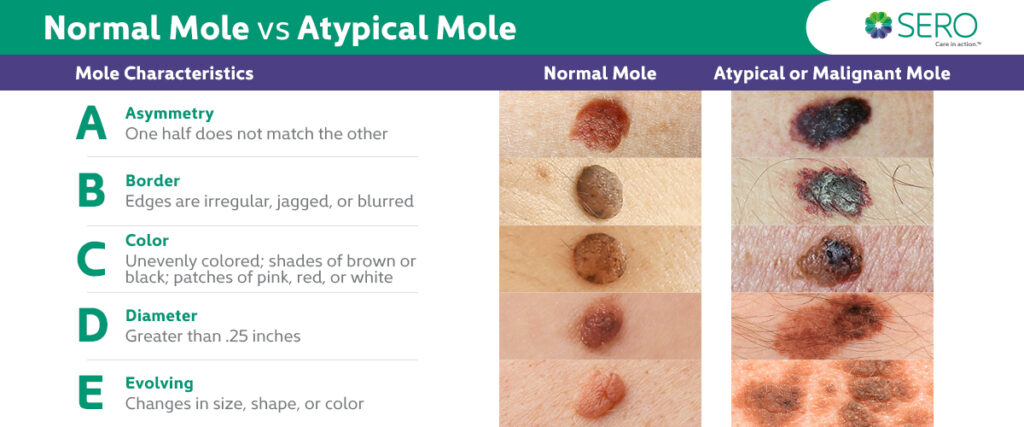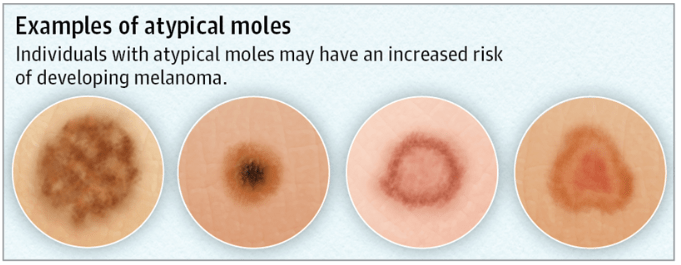
Most people have moles, but some moles are not quite ordinary. These are called dysplastic naevi (or atypical moles) — and while they’re usually harmless, they can be a warning sign of increased melanoma risk.
At Skin Check Australia, our experienced clinicians specialise in identifying and monitoring dysplastic naevi to detect melanoma at the earliest possible stage.
What Are Dysplastic Naevi?
Dysplastic naevi are unusual-looking moles that differ in size, shape, or colour from ordinary moles. They result from mild abnormalities in the growth of melanocytes (the pigment-producing skin cells).
While dysplastic naevi are not cancerous, having them means your skin may be more prone to melanoma — the most dangerous type of skin cancer.
How to Recognise a Dysplastic Naevus

Typical features include:
- Irregular or blurry borders
- Uneven colour (shades of brown, pink, or black)
- Larger than common moles (often >6 mm)
- Slightly raised or flat
- Asymmetrical shape
They often occur on sun-exposed areas like the back, shoulders, and arms, but can appear anywhere on the body.
Dysplastic Naevi and Melanoma Risk

Having one or more dysplastic naevi increases your lifetime risk of melanoma, especially if you also have:
- A family history of melanoma
- Fair skin, freckles, or light eye/hair colour
- A history of sunburns or tanning bed use
- Multiple moles (>50) across your body
People with familial atypical mole and melanoma syndrome (FAMMM) have a particularly high risk and need regular professional skin checks.
How Skin Check Australia Identifies Dysplastic Naevi
Our clinicians use advanced dermoscopy — a magnified imaging technique — to view pigment structures and vascular patterns invisible to the naked eye.
Under dermoscopy, a dysplastic naevus may show:
- Irregular pigment network
- Atypical dots, globules, or streaks
- Variegated colours (light brown to black)
- Subtle asymmetry across the lesion
We also employ digital mole mapping to track changes over time — an essential tool for patients with multiple atypical moles.
When to Worry: The ABCDE Rule
You should have any mole checked if it shows one or more of the following:
- A – Asymmetry: one half doesn’t match the other
- B – Border: irregular, blurred, or notched edges
- C – Colour: uneven or multiple shades
- D – Diameter: larger than 6 mm
- E – Evolving: changing in size, shape, or symptoms (itching, bleeding, crusting)
Even subtle changes in a dysplastic naevus can indicate early melanoma.
Diagnosis and Treatment
- Clinical and dermoscopic examination: First step in assessment.
- Biopsy or excision: Recommended if the lesion shows atypical or changing features.
- Histopathology: Confirms whether the mole is dysplastic and its grade (mild, moderate, or severe atypia).
- Regular monitoring: Ensures new or existing moles remain stable over time.
Severely dysplastic naevi are often surgically removed as a precaution.
Prevention and Self-Care
- Perform monthly self-skin checks using a mirror or partner assistance.
- Protect skin with broad-spectrum SPF 50+ sunscreen daily.
- Avoid tanning beds and limit midday sun exposure.
- Schedule annual professional skin checks (more often if you have a high risk).
Early intervention saves lives — melanoma is highly treatable when detected early.
Why Choose Skin Check Australia
At Skin Check Australia, we provide:
- Comprehensive mole mapping and dermoscopy
- Expert assessment by experienced clinicians
- Photographic monitoring for long-term surveillance
- Professional biopsy and treatment when needed
- Compassionate education and support for sun-safe living
We’re here to ensure your skin stays healthy, safe, and monitored year-round.
Conclusion
Dysplastic naevi are common and usually harmless — but they’re also an important clue to your skin’s melanoma risk.
With expert care and regular screening from Skin Check Australia, you can catch changes early and take proactive steps toward lifelong skin protection.

